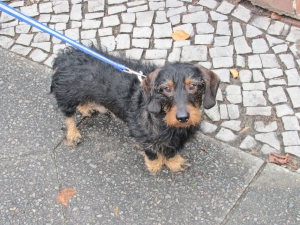 If you never taught a person how to speak or write, they wouldn’t be able to do either – certainly not at a socially acceptable level, at least. The same can be said for obedient walking and your dog. We assume that dogs are hardwired to walk well with us, but unless we put in the time and energy early on in a dog’s life, we’ll be frustrated to discover that by nature dogs like to sniff, lunge, pull, and wander to the beat of their own drum.
If you never taught a person how to speak or write, they wouldn’t be able to do either – certainly not at a socially acceptable level, at least. The same can be said for obedient walking and your dog. We assume that dogs are hardwired to walk well with us, but unless we put in the time and energy early on in a dog’s life, we’ll be frustrated to discover that by nature dogs like to sniff, lunge, pull, and wander to the beat of their own drum.
But we can do something about that. Here’s how to train an obedient walking companion.
What to know before you begin your training
1. A tired dog is a much easier dog to train. This seems a bit like a riddle. Your goal is to train your dog to walk obediently, and walking is one of the best ways to tire your dog out. You can’t really train your dog to to walk “right” unless he’s focused and void of excess energy. So how can you exercise your dog to get him into “train mode” unless he knows how to walk?
Simply, find other ways to tire him out, including fetch, tug o’ war, or bring him to the dog park. You don’t want to resort to walking as your form of dispelling excess energy – at first – because you’ll get frustrated and your dog will learn bad habits. Dogs pull – in large part – due to an excess of energy. So, do all that you can to get rid of that energy before your walking session begins.
2. Rewards are key. Teaching a dog not to pull during a walk requires you to grab his attention from the millions of other things out there. From squirrels, to smells, to barking dogs and more, your dog’s mind will be racing to learn more about what’s happening. But his stomach will always reign supreme. Bring high-reward treats (like cheese, cooked chicken, hot dogs, or peanut butter bits) to keep his attention and so that you can begin to control the pace of the walk.
3. Not so slow and steady. Even dog owners who have bad walkers for pets remark at how well their dog is on a jog (or during a Rollerblade outing). That’s because when dogs are traveling at a faster pace, they have less time to divert their focus. Plus, a faster pace is far more intriguing to a dog. While you may not want to run or Rollerblade with your dog, try to keep a faster pace – at least while you’re training – to captivate your dog’s attention.
4. Set the tone immediately. Many dog owners have the tendency to get their dog amped up to go outside (enter the high-pitched “Wanna go for a walk?”). Don’t do it. In order for your dog to maintain control on a walk, that control needs to be established the moment the leash is introduced. Your dog should be able to stand still before you put his leash on.
The most basic, tried and true how-to-walk training session
The lure and reward tactic is the best – and most practiced – method to train your dog how to walk properly. In this method, you’ll keep several treats in your left hand, while walking with your dog on your right side. Hold your left hand one inch away from your dog’s nose and walk in the direction you want. Every few seconds praise your dog and treat him. If he pulls ahead, immediately stop, ask your dog to sit, and then start again.
With this exercise, you’ll be going through treats quickly. Either keep a reserve of treats in your left pocket (so as not to attract your dog) or a pouch that you keep off to the left side of your body.
Keep training sessions at a minimum. Try 5 minutes at first. Then maybe 10. Don’t overdo it. You’ll frustrate yourself, and your dog (not to mention you’ll overfeed your dog too many treats). Shorter sessions, more frequently throughout the day, are far more productive than one or two longer sessions. And keep in mind that the mental energy your dog will have to exert during these sessions are sure to tire him out.
Over time (like days), increase the time and number of steps before you treat again. As you gradually increase the time in between treats, you’ll be able to get to a few minutes before you have to treat again. You’re well on your way to an obedient walking companion.





